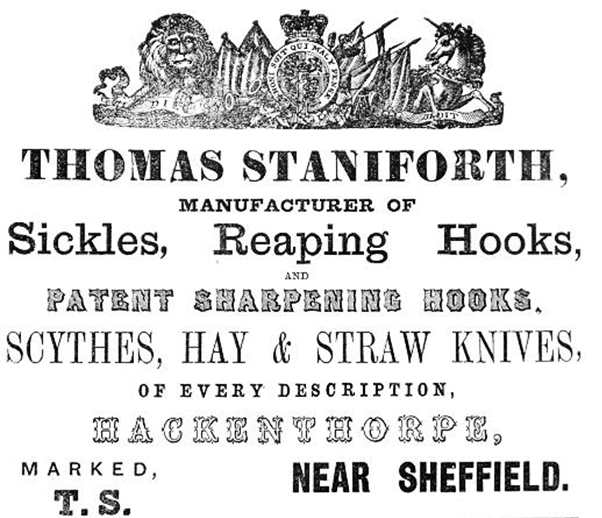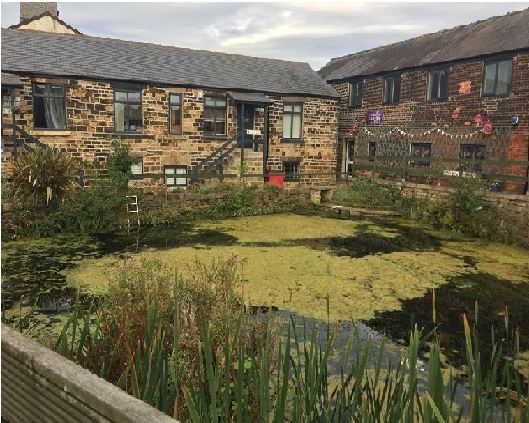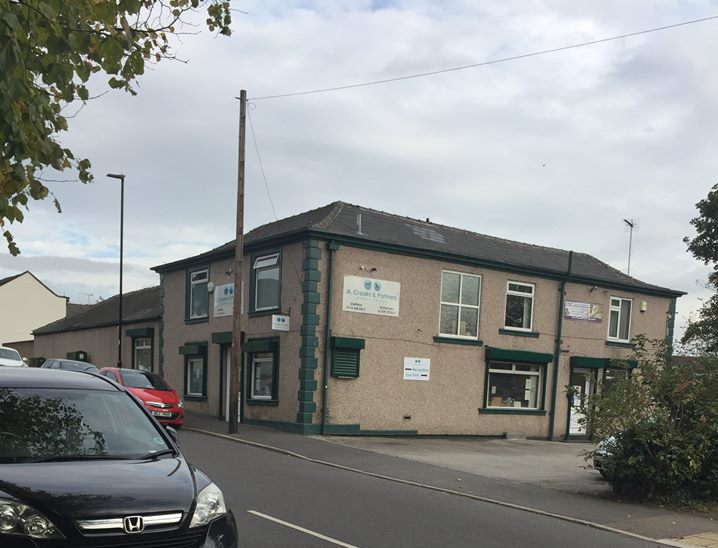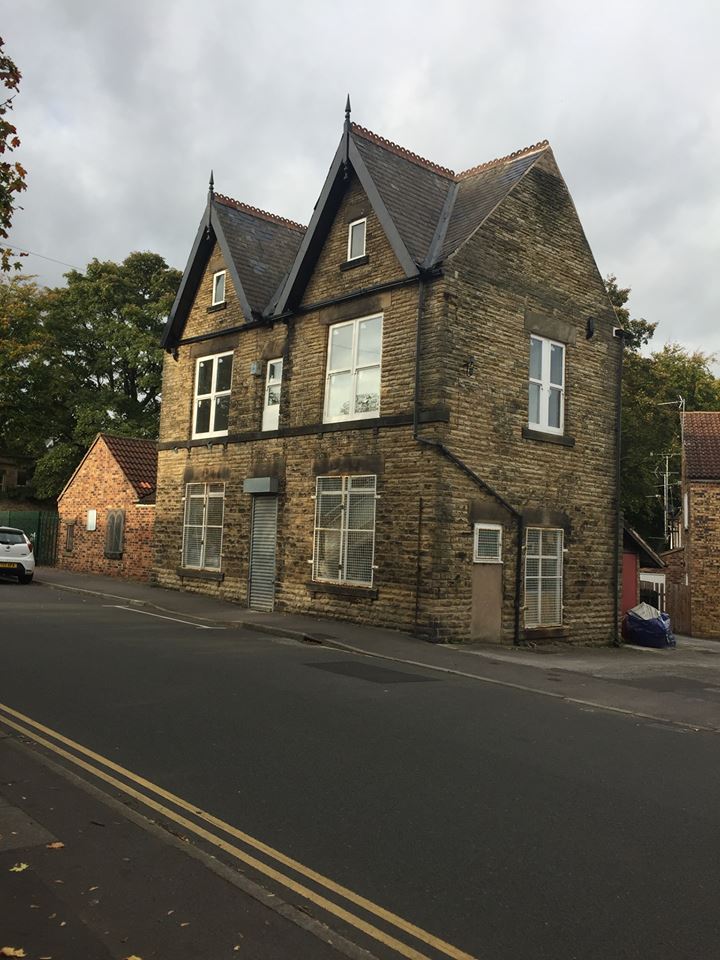
Thomas Staniforth & Co. Sickle works at Hackenthorpe.
 Thomas Staniforth & Co. Sickleworks, Main Street, October 2017
Thomas Staniforth & Co. Sickleworks, Main Street, October 2017
Eckingthorp is an interesting name and bears resemblance to the modern village names of Hackenthorpe and Eckington. Eckingthorp translates to ‘the hamlet of Eck’s people’. During that period the hamlet would have stood in what was then known as the Great Forest which was a large forest that covered most of Derbyshire and the surrounding counties of Nottinghamshire, Yorkshire and Lincolnshire. The remnants of the forest are found in what is now known as Sherwood Forest, the legendary stomping ground of Robin Hood. Looking at Sherwood Forest gives an insight as to how the area surrounding the hamlet would have looked. The Great Forest would have been made up of mostly Oak and Ash trees with various heathlands in the clearings. A prominent features just outside of the hamlet would have been Rother Valley, a large river which still exists today.
Following the end of the Romanic period in Britain the Anglo-Saxons invaded and it was around 500AD when the hamlet of Eckingthorp would have been settled. During this period the island was split between various kingdoms most notably the kingdoms of Mercia and Northumbria. Eckingthorp was settled right on the border between the two kingdoms, on the Mercia side with the nearly Shire Brook stream acting as the border. This left the village prone to being raided and many battles would have been fought in the village and the surrounding area.
A local land owner is listed on court rolls by the name of Hacun Thorpe, this is also a possible source for the villages name. The local 'de Hacunthorpe/Hacunthorp' family that existed in earlier centuries should also be mentioned.
In more recent centuries the village of Hackenthorpe was part of the Beighton parish, Beighton being another small village to the south-east. Most of the inhabitants of the village would venture down to Beighton to attend St. Mary’s church. It would not be until the turn of the 20th century when Hackenthorpe would get its own church.
The modern name of Hackenthorpe emerged during the 14th century during a time when local dialects began to shape the names of villages and hamlets throughout Derbyshire and the midlands. During this time the hamlet was mostly comprised of farmland with a number of farmers working the land and working on the local lord’s domains as well as their own plots. The local forest was also used as a source for charcoal which would then be used to fuel furnaces that would in turn be used to smelt iron that was mined in shallow pits. Coal was also used to heat the homes of the wealthier residents of the hamlet.
One of the oldest buildings still standing in Hackenthorpe is the great Hackenthorpe Hall built in 1653 by John and Alice Newbould. This was a sure sign of the growing wealth of the area and a sign of things to come.
 The Vets, housed in the former New Inn Building
The Vets, housed in the former New Inn Building
In 1743 the Staniforth Works was opened on Main Street by Thomas and John Staniforth, a workshop used for the smithing of farming tools such as scythes and sickles. The Staniforth family was already known in the area and they owned multiple sickle grinding wheels along the Shire Brook stream in what is now known as the Shirebrook Valley Nature Reserve. The works building can still be found at the corner of Main Street and Beighton Road, and the smithy pond is still a prominent feature behind the building.
During the 19th century Hackenthorpe was becoming known across the country and the world due to its industry. In 1813 a small chapel was built on Main Street opposite Hackenthorpe Hall to help serve the growing population. By 1820 the Staniforth Works began embracing steam power and by 1840 the Sheffield Coal Company began working large quarries in the area, most notable at this time would have been the Wiggin Tree at the top of Occupation Lane leading to Birley. 1840 saw the railway arriving at Beighton which followed the course of the Rother Valley river.
In 1855 the first national school opened in Beighton, it would be another few decades before Hackenthorpe would leave the parish, so the local children would have made the journey south east to attend school each morning. This changed in 1880 when land from Lord Manvers was used to open two board schools, one in Beighton and one in the village of Hackenthorpe itself.
It was around this time when the coal mining industry began to boom, and in 1877 the Birley East Pit was opened and was soon producing up to 500 tons of coal daily. It is interesting to look at census records from this time as the employment sees a shift from Sickle smithing and farming to Coal mining.
By 1894 the local government act introduced District and Parish councils and Hackenthorpe and Beighton finally got street names and for the first time got their own split identities. Hackenthorpe was booming and was now a parish in its own right.
 The former reading room on Main Street
The former reading room on Main Street
With the population of the village growing steadily thanks to the coal mines, the colliery owners began buying land and building terraced housing for its workers. During the 1930s a new housing estate was built by Henry Boot, known as Frecheville, prior to this the area to the west of Hackenthorpe was known as Birley Moor.
Following the Second World War in the 1940s the nearby city of Sheffield was in desperate need for more housing, and so a period of rapid house building began in Hackenthorpe and the surrounding areas. As a result of this Hackenthorpe village became part of the city of Sheffield in 1967. This was a historic moment as it meant the village left the county of Derbyshire and joined Yorkshire. Many of the residents protested this move however it was inevitable and on April 1st 1967 the move was made official.
Following this period extensive building was conducted in the surrounding areas and another town was created known as Mosborough which can now be found to the south, in between Hackenthorpe and the village of Eckington.
Now we come to the 21st century, what was once a village of coal miners, sickle smiths and farmers is now just like any other suburb in Sheffield. Gone are the large open quarries, the sound of hammers hitting steel. Many remnants of the past still remain, the Hackenthorpe Hall still stands proudly on Main Street, now used as a nursery for children. The gate posts that once signaled the entrance to Mr Hounsfields Cotleigh Hall are still present next to the aptly named Cotleigh Cottages and of course Christ Church itself is still frequented by local worshippers. The Staniforth works buildings now house small businesses and the Staniforths house Greenside is present beside the works.